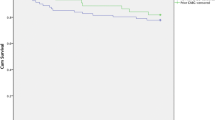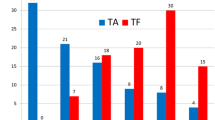Abstract
Objective
Transcatheter aortic valve implantation (TAVI) is a therapeutic option for old and multimorbid patients with severe aortic stenosis. When applying the groin first approach by transfemoral implantation, patients in the transapical group are highly selected with even higher morbidity. We report outcome of the transapical group.
Methods
Between April 2008 and May 2011, 267 patients underwent TAVI through either a transfemoral (n = 201 CoreValve, n = 33 Edwards Sapien prostheses; mean age 81 ± 6 years, logistic EuroSCORE 19.5 ± 12.6 %; 4–76, STS score 7.2 ± 4 %; 1.5–28.9) or transapical approach (n = 33 Edwards Sapien prostheses; mean age 80 ± 1 years, logistic EuroSCORE 31.6 ± 17.1 %; 9.4–69.1, STS score 12.8 ± 7.1 %; 2.5–28.8). The transapical access was chosen only when transfemoral implantation was not possible.
Results
EuroSCORE and STS score were significantly higher in the transapical group (p = 0.001, respectively). A 30-day survival was comparable with 87.9 % in the transapical versus 92 % in the transfemoral group (p = 0.52). In the transapical group, female gender was predominant (n = 23; 70 %). Eight patients underwent previous cardiac surgery. All transapical implantations were successful. No bleeding or neurological complications occurred. Six patients required postoperative pacemaker implantation. Cardiac decompensation with concomitant pneumonia was the underlying cause for early mortality, except for one patient with abdominal malperfusion. Follow-up (0–37 months) was complete in 100 %, nine patients died after 30 days postoperatively (6 cardiac and 3 non-cardiac related). Echocardiography revealed good valve function with not more than mild paravalvular incompetence.
Conclusions
Groin first approach is reasonable due to less invasive implantation technique. However, despite even higher predicted mortality, transapical aortic valve implantation is non-inferior to transfemoral approach.


Similar content being viewed by others
References
Rao V, Christakis GT, Weisel RD et al (1996) Changing pattern of valve surgery. Circulation 94:113–120
Lichtenstein SV, Cheung A, Ye J et al (2006) Transapical transcatheter aortic valve implantation in humans: initial clinical experience. Circulation 114:591–596
Beyersdorf F (2007) Transapical transcatheter aortic valve implantation. Eur J Cardiothorac Surg 31:7–8
Walther T, Falk V, Borger MA et al (2007) Minimally invasive transapical beating heart aortic valve implantation—proof of the concept. Eur J Cardiothorac Surg 31:9–15
Walter T, Simon P, Dewey T et al (2007) Transapical minimally invasive aortic valve implantation: multi-center experience. Circulation 116(11 Suppl):I240–I245
Ye J, Cheung A, Lichtenstein V et al (2007) Six-month outcome of transapical transcatheter aortic valve implantation in the initial seven patients. Eur J Cardiothorac Surg 31:16–21
Leon MB, Smith CR, Mack M et al (2010) Transcatheter aortic-valve implantation for aortic stenosis in patients who cannot undergo surgery. N Engl J Med 363:1597–1607
Figulla L, Neumann A, Figulla HR et al (2011) Transcatheter aortic valve implantation: evidence on safety and efficacy compared with medical therapy. A systematic review of current literature. Clin Res Cardiol 100:265–276
Leon MB, Piazza N, Nikolsky E et al (2011) Standardized endpoint definitions for transcatheter aortic valve implantation clinical trials: a consensus report from the Valve Academic Research Consortium. Eur Heart J 32:205–217
Gilard M, Eltchaninoff H, Iung B, FRANCE 2 Investigators et al (2012) Registry of transcatheter aortic-valve implantation in high-risk patients. N Engl J Med 366:1705–1715
Beller CJ, Bekeredjian R, Krumsdorf U et al (2011) Transcatheter aortic valve implantation after previous mechanical mitral valve replacement: expanding indications? Heart Surg Forum 14:E166–E170
Svesson LG, Dewey T, Kapadia S et al (2008) United States feasibility study of transcatheter insertion of a stented aortic valve by the left ventricular apex. Ann Thorac Surg 86:46–54
Walther T, Falk V, Kempfert J et al (2008) Transapical minimally invasive aortic valve implantation: the initial 50 patients. Eur J Cardiothorac Surg 33:983–988
Ye C, Cheung A, Lichtenstein SV et al (2009) Transapical transcatheter aortic valve implantation: 1-year outcome in 26 patients. J Thorac Cardiovasc Surg 137:167–173
Zierer A, Wimmer-Greinecker G, Martens S, Moritz A, Doss M (2008) The transapical approach for aortic valve implantation. J Thorac Cardiovasc Surg 136:948–953
Bleiziffer S, Ruge H, Mazzitelli D et al (2009) Survival after transapical and transfemoral aortic valve implantation: talking about two different patient populations. J Thorac Cardiovasc Surg 138:1073–1080
Thomas M, Schymik G, Walther T et al (2011) One-year outcomes of cohort 1 in the Edwards SAPIEN aortic bioprosthesis European Outcome (SOURCE) Registry: the European registry of transcatheter aortic valve implantation using the Edwards SAPIEN valve. Circulation 124:425–433
Puls M, Viel T, Danner BC et al (2012) The risk-to-benefit ratio of transcatheter aortic valve implantation in specific patient cohorts: a single-centre experience. Clin Res Cardiol. doi:10.1007/s00392-012-0426-4
Piazza N, Wenaweser P, van Gameren M et al (2010) Relationship between the logistic EuroSCORE and the Society of Thoracic Surgeons predicted risk of mortality score in patients implanted with the CoreValve revalving system—a Bern-Rotterdam study. Am Heart J 159:323–329
Afilalo J, Karunananthan S, Eisenberg MJ, Alexander KP, Bergman H (2009) Role of frailty in patients with cardiovascular disease. Am J Cardiol 103:1616–1621
Engelman DT, Adams DH, Byrne JG et al (1999) Impact of body mass index and albumin on morbidity and mortality after cardiac surgery. J Thorac Cardiovasc Surg 118:866–873
Higgins TL (1998) Quantifying risk and assessing outcome in cardiac surgery. J Cardiothorac Vasc Anesth 12:330–340
Cigolle CT, Ofstedal MB, Tian Z, Blaum CS (2009) Comparing models of frailty: the health and retirement study. J Am Geriatr Soc 57:830–839
Hogan DB, MacKnight C, Bergman H (2003) Models, definitions, and criteria of frailty. Aging Clin Exp Res 15:1–29
Osten MD, Feindel C, Greutmann M et al (2010) Transcatheter aortic valve implantation for high risk patients with severe aortic stenosis using the Edwards Sapien balloon-expandable bioprosthesis: a single centre study with immediate and medium-term outcomes. Catheter Cardiovasc Interv 75:475–485
Bauernschmitt R (2011) Transcatheter aortic valve replacement (TAVI)—risk factors for 90-day mortality. Intervent Med Appl Sci 3:128–133
Kempfert J, Rastan A, Holzhey D et al (2011) Transapical aortic valve implantation: analysis of risk factors and learning experience in 299 patients. Circulation 124(Suppl 1):S124–S129
Rodes-Cabau J, Webb JG, Cheung A et al (2010) Transcatheter aortic valve implantation for the treatment of severe symptomatic aortic stenosis in patients at very high or prohibitive surgical risk: acute and late outcomes of the multicenter Canadian experience. J Am Coll Cardiol 55:1080–1090
Smith CR, Leon MB, Mack MJ et al (2011) PARTNER Trial Investigators. Transcatheter versus surgical aortic-valve replacement in high-risk patients. N Engl J Med 364:2187–2198
Conflict of interest
The authors declare that they have no conflict of interest.
Author information
Authors and Affiliations
Corresponding author
Additional information
C. J. Beller and B. Schmack contributed equally to this work.
Rights and permissions
About this article
Cite this article
Beller, C.J., Schmack, B., Seppelt, P. et al. The groin first approach for transcatheter aortic valve implantation: are we pushing the limits for transapical implantation?. Clin Res Cardiol 102, 111–117 (2013). https://doi.org/10.1007/s00392-012-0502-9
Received:
Accepted:
Published:
Issue Date:
DOI: https://doi.org/10.1007/s00392-012-0502-9




